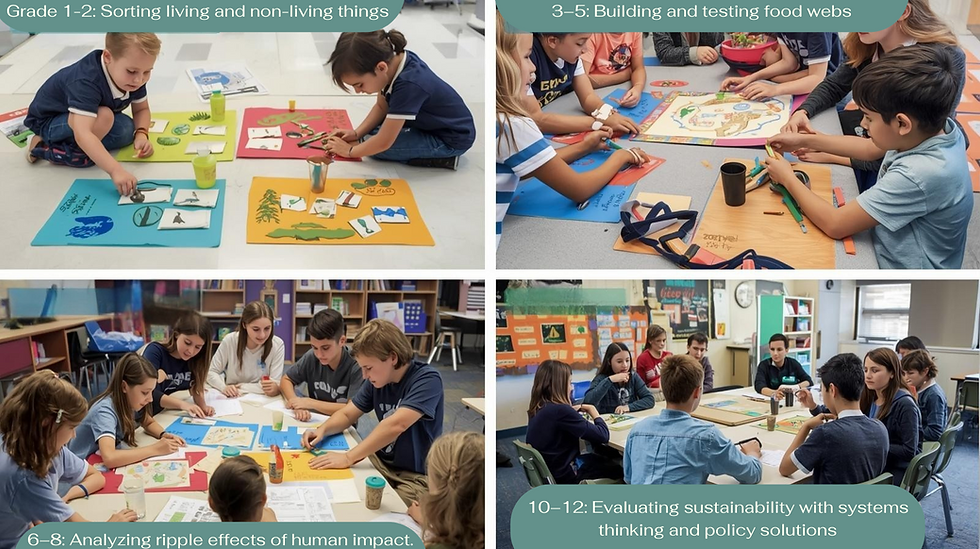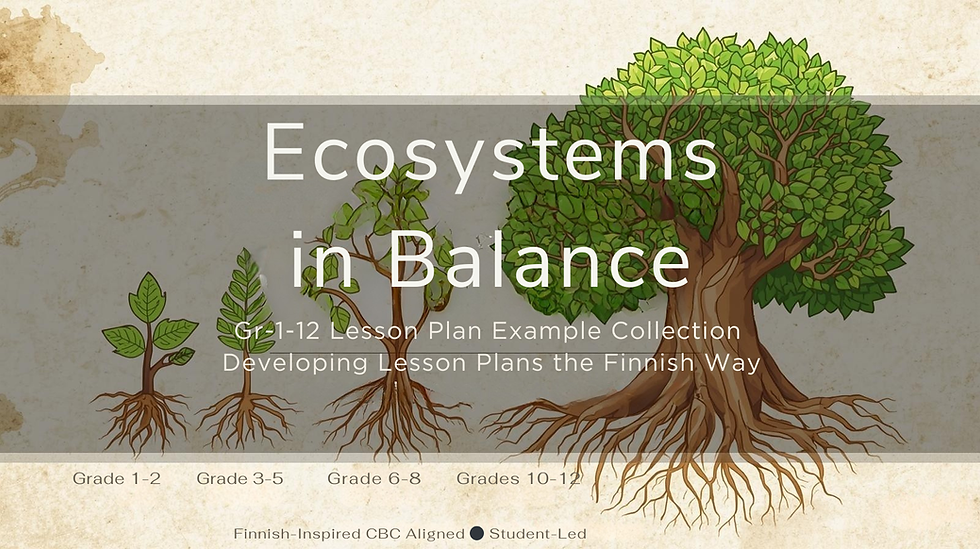🌱 Why Finnish Lesson Planning Feels Lighter (and How to Try It)
- vanessa speigle
- Sep 16
- 3 min read
If you’ve ever felt weighed down by lesson plans: pages of objectives, scripts, and outcomes, you’re not alone. In many systems, good planning gets confused with long, rigid paperwork.
Step into a Finnish classroom, though, and you’ll notice something different: lesson plans are still intentional, but they feel lighter, freer, and more sustainable.

🎯 What Makes Finnish Lesson Plans Lighter?
Finnish lesson plans aren’t minute-by-minute scripts. They are guides built around learning outcomes, the skills students will be able to show, rather than long lists of objectives.
Clear skills, not scripts. Each lesson begins with a skill statement like:“Students in Grade 1 math will be able to find larger and smaller numbers using objects or manipulatives.”The teacher knows what skill must be visible, but is free to choose how students get there.
Student agency. Plans include guiding prompts like “How do you know 7 is bigger than 5?” that invite reasoning and dialogue.
Active, playful methods. Concrete tools, movement, and storytelling are woven into every subject.
Built-in well-being. A rhythm of ~45 minutes of work followed by a 15-minute outdoor break sustains focus.
Flexibility. Teachers are trusted to adapt in the moment, if curiosity takes a new turn, the plan shifts while the outcome remains.
🔍 Real Examples From Finnish Classrooms
Math (Grades 1–3): A Grade 1 teacher introduces comparing numbers by asking: “I have 3 apples, you have 5; who has more?” Students use counters or drawings to explore greater/less than. Skill outcome: “Students will be able to compare and order numbers using manipulatives.”
Science (Grades 7–9): Students build a “Microworld in a Shoebox” ecosystem, integrating science, art, and storytelling. Outcome: “Students will be able to model an ecosystem and explain interactions between organisms.”
Language + Digital Literacy (All Grades): Students turn the human circulatory system into a fairy tale, then translate it into English for a partner school abroad. Outcome: “Students will be able to communicate scientific content through digital storytelling.”
Social Studies (Grades 9–12): In a Cold War unit, students progress at their own pace, curating resources in shared docs. Outcome: “Students will be able to research, synthesize, and explain key events of the Cold War.”
Math Through Play (Grades 1–6): Students count hops, jumps, and pebbles woven into stories. Outcome: “Students will be able to demonstrate counting skills through play and movement.”

🌱 But What If You’re Micromanaged?
Not every school gives teachers the freedom Finland does. You might have to hand in detailed plans or prove every outcome.
The catch: you can still plan flexibly, as long as your focus is on visible student learning.
👉 Try this micromanager-proof overlay:
Post the skill focus on the board.
Guarantee two student products (poster, notebook page, exit ticket) and save a few samples.
Add two checkpoints (mid-lesson probe + end share).
Embed a quick peer/self-assessment.
Snap photos of work or jot a 3-line reflection after class.
This way, anyone can see exactly what students learned, while you keep flexibility in how they learned it.
📥 Try a Rekla-Style Flexible Lesson (Free Sample)
We’ve created a downloadable Rekla 19-section Finnish-inspired lesson plan you can use right away:
This is a standalone lesson for Grades 3–5, written in our full Rekla format with:
Warm-ups, stations, and peer reflection.
A student-friendly rubric.
A quick evidence plan for supervisors.
A micromanager-proof overlay.
It’s designed to be flexible, student-centered, and globally adaptable whether you teach in CBC classrooms in Kenya or anywhere else in the world.
🌍 Go Deeper: The Gr. 1–12 Collection
The sample is just one slice of what’s possible. Our new collection; “How-To: Lesson Plan the Finnish Way – Gr. 1–12” expands the ecosystems theme across all grade levels:

1–2: Sorting living vs. non-living through play.
3–5: Building and testing food webs (the sample lesson).
6–8: Analyzing ripple effects of human impact.
10–12: Evaluating sustainability with systems thinking and policy solutions.
Each grade band comes with:

A full 19-section Rekla lesson plan.
Student rubrics and evidence plans.
Built-in reflection and action breaks.
Cross-subject integration and large group adaptations.
🌱 The Rekla Lens
When Finnish design meets global competency-based learning, classrooms become:
Less rushed (depth over quantity)
More connected (cross-subject and real-world)
Sustainable (teacher-friendly, student-centered, rooted in well-being)
Our YouTube Channel is LIVE! YAH! Subscribe and join the Rekla Movement to change education globally.
🌱 Rekla Reflection Question:
Which part of your lesson planning this week could you lighten: the script, the number of activities, or the way students show their learning?





Comments